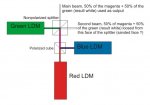HIMNL9
0
- Joined
- May 26, 2009
- Messages
- 5,318
- Points
- 0
It can be done - Life long experimenter
rog made a white pointer by combining a red, green, and blue laser in the kes-400aa(?) sled and the optics inside. check out his website.
Yes, but there is just a pair of things that you have not considered, i think.
First, the second cube of that sled is apparently not a polarizer, but just a splitter / joiner
second, that goal was not to add power to power, but to add 3 different wavelenght.
So, let me do an example ..... first is a polarized joiner, that join red and blue in h and v polarization schemes, and get a nagenta beam with 2 polar planes ..... that, passing through the second cube, got splitted in 2, and at the same time, added with 50% of the green beam, also this splitted in 2, like in the attached image .....
I never seen that assembly working (mean, the unit powered up and the beams paths inside the cubes), but i bet a beer that my theorical model is near enough the reality




